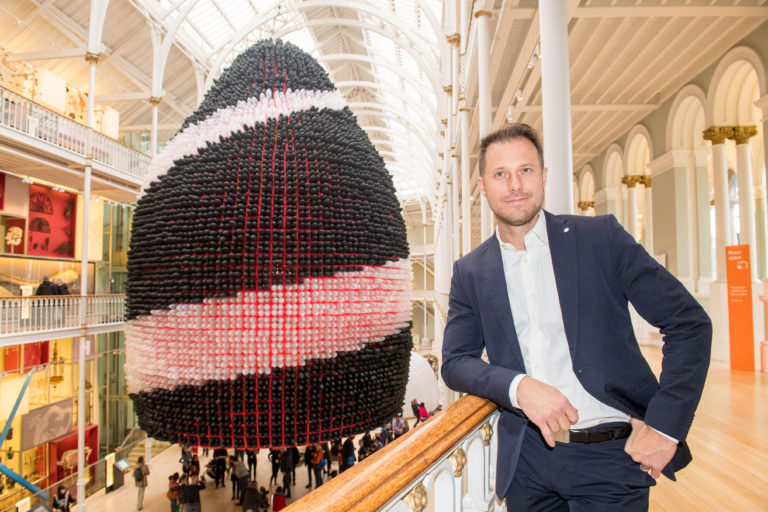
A giant sculpture featuring over 25,000 balloons – painstakingly put together by a team of 13 people over 6 days – is to form the centrepiece of this year’s Edinburgh International Science Festival.
Event Horizon is American artist Jason Hackenwerth’s largest ever work and was unveiled today at the National Museum of Scotland as part of a series of events tied to the two week science festival.
Descending from the ceiling of the Museum’s Grand Gallery, the work involved local art and science fans from various backgrounds including science communications, history of art and filmmaking.
The new sculpture is part of Existence: Life and Beyond a new Science Festival-created interactive exhibition which opened at the National Museum of Scotland on 31 March. It guides audiences on a journey from the origins to the future of life, but ‘not necessarily as we know it’.
Existence: Life and Beyond is part of Scotland’s Year of Young People 2018 and has been programmed with assistance from the Science Festival’s Youth Consultation Group. This group of 12 young people closely works with the Science Festival team to create content with and for them and their peers, helping connect the Festival with teen audiences.
The Science Festival’s Youth Consultation Group are interested in getting people thinking about what life means, and how we perceive the intelligence of computers. They will be presenting online examples of AI creativity and machine learning, asking visitors to interact and question how close computers can get to exhibiting human-like intelligence.
The exhibition is developed with support from Creative Scotland through the Scottish Government’s Edinburgh Festivals Expo Fund and supported by the Year of Young People 2018 event fund, managed by EventScotland, part of VisitScotland’s Events Directorate.
Culture Secretary Fiona Hyslop said: “This unveiling of Jason Hackenwerth’s sculpture as part of this year’s Edinburgh International Science Festival is really exciting, merging art with science – and certainly one of the highlights of the festival’s rich programme of events. I commend the Science Festival for their continued commitment to ensuring international audiences come together in Scotland every year.
“I am pleased that the Scottish Government supported this year’s edition of the Festival by providing £130,000 Expo funding for Existence: Life and Beyond and Synthetica. As we celebrate 2018 Year of Young People, this funding will ensure the festival can continue to present cutting-edge technology showcase and innovative events for our teenagers and young people.”
Hackenwerth said: “I am very pleased to be back at the Science Festival with my biggest work yet, Event Horizon. Using balloons to make sculptures has magical results as well as built-in challenges: the works are instantly recognisable as an exuberant celebration of life, and require no deep understanding of art to enjoy, but are temporary. This fleeting fact increases its rarity and urgency to see it while it lasts. I hope the Science Festival audiences will enjoy getting lost in the gigantic rotating chasm of the Event Horizon.”
Amanda Tyndall, Festival and Creative Director at Edinburgh International Science Festival said: “I can’t express how delighted we are to have Jason back with us in this very special 30th birthday year. It is with projects like this that see science merge with the arts and digital and creative industries that we reach new audiences, keep innovating and try to ensure we are around for the next 30 years and beyond.”
Ellie Armstrong was one of the 13 people who worked with Jason Hackenwerth on Event Horizon. She usually works as a science communicator at the Science Museum London, and is writing a PhD on how curatorial ideas and directions in the arts could be used to ‘pluralise the science museum space’.
Ellie, an Artist’s Assistant, said: “I got involved with Event Horizon because I’m interested in how we imagine areas of science we simply can’t experience. By building Event Horizon, we are inviting people to speculate and imagine what it’s like to go to places that cannot be reached and question what might happen there. The sheer scale of the project and the fact that it’s made of familiar balloon materials to children means that there’s an element of it being relatable to their experience but also so completely different that everyone stops and stares. Balloons are normally thought to be light and thin, but Event Horizon is also demonstrating the surprising strength of the balloons we’re using and their weight when there are so many of them.”


![Edinburgh International Film Festival announces collaboration with Edinburgh Festival Fringe, unveiling new venues and programming strands EIFF[1]](https://eventsbase.co.uk/wp-content/uploads/2024/04/EIFF1.png)
![Edinburgh International Film Festival announces 2025 Festival Footprint EIFF[1]](https://eventsbase.co.uk/wp-content/uploads/2025/07/EIFF1.png)
